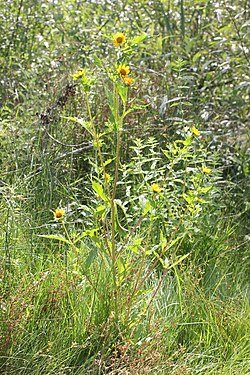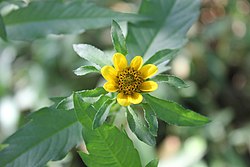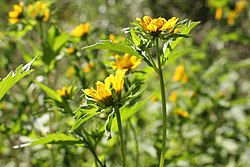Biology:Bidens amplissima
| Bidens amplissima | |
|---|---|

| |
| Scientific classification | |
| Kingdom: | Plantae |
| Clade: | Tracheophytes |
| Clade: | Angiosperms |
| Clade: | Eudicots |
| Clade: | Asterids |
| Order: | Asterales |
| Family: | Asteraceae |
| Genus: | Bidens |
| Species: | B. amplissima
|
| Binomial name | |
| Bidens amplissima Greene
| |
| Synonyms[1] | |
| |
Bidens amplissima, also known as the Vancouver Island beggarticks, is an annual wetland species in the family Asteraceae which displays a broad range of morphological variation and has a geographic range restricted to southwestern British Columbia and adjacent Washington (state) . Due to its limited global range and susceptibility to anthropogenic threats, B. amplissima is federally listed as Special Concern under Canada 's Species at Risk Act and is blue-listed in British Columbia.[2] Bidens amplissima shares a variety of morphological characteristics with two closely related species, B. cernua and B. tripartita, making identification challenging.[3][4] Accurate identification also often depends on multiple morphological characters such as leaf shape, ray florets and achene shape.[3]
Distribution and abundance
The global distribution of B. amplissima is restricted southwestern British Columbia and area of adjacent Washington State.[2][5] Bidens amplissima was thought to be endemic to British Columbia until 2002 when specimens held at a herbarium in Washington State were found to be originally misidentified as B. cernua and were in fact B. amplissima.[6] Populations are thought to exist in Snohomish County. However, there are no published records on the size of populations in the United States (US).[3]
Although its global geographic range is restricted mainly to British Columbia, more than 85% of its known range, many uncertainties remain regarding the current abundance and distribution.[2] There are some reports of the plant also being found in Manitoba and Nebraska, but these are almost certainly introductions.[7][8][9][10]
As of 2014, B. amplissima has been recorded at 59 locations throughout British Columbia with 27 locations occurring on Vancouver Island. No surveys have been conducted to examine the presence or abundance of B. amplissima within its known range.[3]
Habitat
Bidens amplissima can often be found at the edges of wetlands, bogs, and tidal areas with fluctuating water levels[3][6][11] and often occupies openings at the edges of wetlands.[2] Although B. amplissima most often occurs on the edges of ponds and streams, it can also be found in tidal zones.[7][12][13] Lastly, as a hydrophyte, B. amplissima is most prolific in hydric soils.[3]
Morphology
General description
Bidens amplissima is an annual species growing up to 120 cm (4 feet) tall.[11] Roots are fibrous, stems are rigid and branching.[8]
Stem leaves are opposite, unstalked, and the lower and middle leaves are often deeply three-lobed. However, leaves are also often simple and not lobed. The leaf margin is coarsely toothed or incised, glabrous, and roughly 8–20 cm long.
Bidens amplissima produces numerous yellow flower heads containing both disc florets and ray florets.[11] Ray and disk flowers and occur in a terminal cluster at the top of the plant. Involucral bracts are in two rows, the outer ones about 8–10, leafy, fringed with small hairs, linear-lanceolate with entire margins, up to 7.5 cm long, the inner ones narrowly egg-shaped, 8–12mm long. Ray flowers are 8–11, yellow, 3.5–8mm long, while disk flowers are yellow.[14]
The fruits of Bidens amplissima are achenes which are wedge-shaped with flat or concave summits. Achenes are 5–7mm long, with retrorsely-barbed awns which are 2–4mm long.[14]
Morphological variation
Bidens amplissima is often confused with two closely related species, B. cernua and B. tripartita. B. amplissima can be distinguished from B. cernua, which has cartilaginous and concave achene summits, globular flower heads, and more numerous petals than B. amplissima. Bidens amplissima can also be separated from B. tripartita, which can be very similar in appearance, however B. tripartita lacks ray petals.[14]
Phylogeny and genetics
The current view regarding the phylogenetic history of B. amplissima is that it originated as a hybrid of B. cernua and B. tripartita sometimes after the last glaciation. This view is strongly supported by the morphological traits shared among these species, the small distribution of B. amplissima, and genetic analysis.[3] Despite its relatively recent origins, B. amplissima displays distinct genetics when compared to its parent species.[3][15]
An examination of Polynesian Bidens by Ganders et al. (2000) also described the ITS base sequences and isozymes of four species from North America. This study strongly indicated that B. amplissima was most closely related to B. cernua and B. tripartita, given that the genetics of these species were almost identical.[16]
Conservation
Bidens amplissima is Federally listed as Special Concern under Canada's Species at Risk Act. Given that most of its range is restricted to southwestern British Columbia, more than 85% of its known range, conservation and management within the province is crucial to the longevity of the species.[3]
References
- ↑ The Plant List, Bidens amplissima Greene
- ↑ 2.0 2.1 2.2 2.3 Vancouver Island Beggarticks Working Group. 2014. Management plan for the Vancouver Island beggarticks (Bidens amplissima) in British Columbia. Prepared for the B.C. Ministry of Environment, Victoria, BC. 24 pp.
- ↑ 3.0 3.1 3.2 3.3 3.4 3.5 3.6 3.7 3.8 Buchanan, J., Currie, C., Stewart, D. (2015). Habitat associations dormancy, and germination of Vancouver Island beggarticks (Bidens amplissima): restoring populations in British Columbia. Prepared for British Columbia Institute of Technology, Burnaby, BC. 62 pp.
- ↑ Ganders, F. R., Klinkenberg, R., & Klinkenberg, B. (2003). Taxonomy in Conservation Biology: The Enigmatic Vancouver Island Beggarticks. Davidsonia vol 14(3), 63-70.
- ↑ Biota of North America Program 2014 county distribution map
- ↑ 6.0 6.1 Ganders, F. R., Klinkenberg, R., & Klinkenberg, B. (2002). British Columbia loses an endemic species: Bidens amplissima (Asteraceae) also occurs in Washington state. Botanical Electronic News (BEN) No. 293. http://www.ou.edu/cas/botany-micro/ben/ben293.html
- ↑ 7.0 7.1 Ganders, F. R., B. Klinkenberg, and R. Klinkenberg. 2003. Taxonomy in conservation: The enigmatic Vancouver Island beggarticks. Davidsonia 14: 63–70.
- ↑ 8.0 8.1 Electronic Atlas of the Flora of British Columbia, Bidens amplissima (vancouver island beggarticks) includes photos and British Columbia range map
- ↑ Burke Museum of Natural History and Culture, University of Washington, Bidens amplissima Page Author: Don Knoke Vancouver Island beggar ticks includes photos and Washington range map
- ↑ Fred Ganders 2003. British Columbia loses an endemic species: Bidens amplissima (Asteraceae) occurs also in Washington State. Botanical Electronic News No. 293 July 12, 2002
- ↑ 11.0 11.1 11.2 Flora of North America, Bidens amplissima Greene, Pittonia. 4: 268. 1901.
- ↑ Bryant, S. B. (2013). 2013 Surveys for Vancouver Island Beggarticks (Bidens amplissima) in the Little Campbell River Watershed. A Rocha Canada Conservation Science Series. A Rocha Canada, Surrey, B.C., Canada.
- ↑ Klinkenberg, B., & Klinkenberg, R. (2001). COSEWIC status report on the Vancouver Island beggarticks Bidens amplissima in Canada, in COSEWIC assessment and status report on the Vancouver Island beggarticks Bidens amplissima in Canada. Committee on the Status of Endangered Wildlife in Canada. Ottawa. 1-25 pp.
- ↑ 14.0 14.1 14.2 "E-Flora BC Atlas Page". https://linnet.geog.ubc.ca/Atlas/Atlas.aspx?sciname=Bidens%20amplissima.
- ↑ Helenurm, K., & Ganders, F. R. (1985). Adaptive radiation and genetic differentiation in Hawaiian Bidens. Evolution, 39(4), 753-765.
- ↑ Ganders, F. R., Berbee, M., & Perseyedi, M. 2000. ITS base sequence phylogeny in Bidens (Asteraceae): Evidence for the continental relatives of Hawaiian and Marquesan Bidens. Systematic Botany, 25(1), 122-133.
External links
- South Coast Conservation Program, Vancouver Island Beggarticks, Bidens amplissima
- Angiosperms
- Asteraceae
- Bidens
- Bidens cernua
- Bidens tripartita
- British Columbia
- Pacific northwest
- Species at Risk Act
Wikidata ☰ Q2901703 entry
 |






